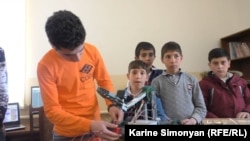Long after classes finish in the village of Aygek, the lights in one room of the school building burn late into the evening.
Inside, 25 students are tapping on keyboards and assembling simple robots. It is a strange sight in this village close to Yerevan where children usually grow up to become farmers or shopkeepers like their parents.
Don't these kids feel out of step with their peers?
"My friends sometimes say that I spend too little time with them because I spend a lot of time in front of my computer," says Vazgen Hovhannisian, who is 16 and busy creating a new computer game. "But now all of my friends play the games I've programmed."
The village computer club is part of a quiet revolution going on in Armenia that could dramatically change the country's economic fortunes in the future.
Largely agricultural Armenia suffers from double-digit unemployment and nearly one-third of the population lives below the poverty line. But a burgeoning IT sector is giving hope that this landlocked land in the heart of the Caucasus could play a significant role in the global computer industry and one day grow prosperous through virtual commerce.
While Armenia's overall economic growth rate was 3 percent in 2015, the IT sector has grown at an average rate of about 22 percent annually since 2008. Today, the IT sector employs some 15,000 people.
That makes it an eye-popping success story in a country which, apart from mineral resources, has few products to export internationally. Armenia's economic situation is further constrained by a continuing trade embargo imposed by two of its neighbors, Turkey and Azerbaijan, over the disputed territory of Nagorno-Karabakh.
The Soviet Union's 'Silicon Valley'
Industry association leaders say they hope that by promoting IT the country can revive days past when, long before the Internet, Armenia was one of the computer powerhouses of the Soviet Union.
"Before 1990, Armenia designed and produced one-third of all the Soviet Union's military electronics, with something like 100,000 people working in this area," says Karen Vardanian, head of the Union of Information Technology Enterprises in Yerevan.
During the Soviet era, the now-defunct Yerevan Research Institute of Mathematical Machines alone had about 10,000 employees as late as in the 1980s. But the collapse of Armenia's economy that followed the breakup of Soviet Union in 1991 dealt a heavy blow to the country's high-tech sector as well as to funding for mathematics and science education in its universities.
"While other countries like India and Taiwan became IT powerhouses, Armenia -- once considered the Soviet Union's Silicon Valley -- languished," Vardanian notes.
Over the past decade, however, IT has made a rapid comeback.Of nearly 500 IT firms operating in Armenia today, almost half have opened since 2007.
The growth has come as diaspora Armenians in the U.S. and European IT industries have reached back to Armenia as a lower-cost source of skilled labor. A computer professional in Armenia can make $1,500 a month, five times the Armenian average wage, but still a fraction of the average monthly amount of $4,300 earned by an entry-level programmer in the United States.
Local Startups
The early foreign pioneers have been followed by others, including in recent years some of the biggest names in the global software development industry such as Oracle and Taiwan's D-Link Corporation, both of which have opened offices in Yerevan.
But the country has also seen a boom in homegrown IT businesses. One of them, PicsArt, has become one of the world's most popular mobile photo-editing and sharing applications. It was listed by Forbes in 2015 as one of the world's 50 "hottest startups."
Recognizing the potential, the Armenian government has fostered the sector's growth with tax breaks, including offering tax incentives to startups that employ up to 30 people. The government is also considering giving computer professionals a special 10 percent income-tax rate, compared to the usual 15 percent rate.
But success has come at an ironic price. Armenia's IT industry today is at the point where its need for trained professionals has grown faster than the country's supply of qualified people.
Industry experts estimate the sector needs some 2,000 more IT graduates than are available, something that gives people like Samvel Shoukourian, who heads Yerevan State University's IT Educational and Research Center, good reason for headaches.
"Armenia needs to create a pipeline to produce this set of very qualified information technology specialists because for the moment we have a lack of specialists and every new company that comes to Armenia is interested in a huge number of specialists," he says.
The shortcomings in the educational system have given rise to a growing network of technology centers for "training up" today's computer graduates. There are nine centers in Yerevan providing additional training for IT professionals and a government-backed "technopark" serving the same purpose in Armenia's second-largest city, Gyumri.
But it is not just today's computer graduates who are getting attention. The IT industry is also busy encouraging the next generation to get into the field.
In the village of Aygek, computer teacher Shusan Grigorian hopes that IT will offer her students a possibility to find work without having to go abroad.
"IT is an area where it does not matter in which corner of the world you are located, because if you are connected to the Internet, it means you’re in the center of the world," she says.















